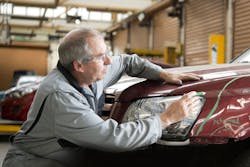The small jobs were piling up for Randy Sattler. Although the dealership body shop he managed, Rydell Collision Center in Grand Forks, N.D., was on course to do $6 million in sales this year, the average repair order of under $1,000 meant that there were a tremendous amount of small jobs coming through the shop each day.
“If we have a repair that was dropped off at 9 a.m. and it’s a front bumper cover that needs to be painted, if it just got tossed into the same production line as the other vehicles, that vehicle wouldn’t get done the same day,” he says. “It would fall into queue with the others, even though it should have moved to the top of the line. It was causing us not to get the repairs done in a timely manner.”
That’s why, three years ago, Sattler decided to add a cosmetic repair section to the shop. Those “out-of-the-booth” jobs—including micro dent repair, wheel repair, headlamp refurbishment, chip repair and door dings—now make up an extra $17,000 in monthly sales that the shop is able to turn over more quickly and efficiently.
—Randy Sattler, collision center manger, Rydell Collision Center
The key to an effective cosmetic repair section, Sattler says, is speed and efficiency. To remain profitable, Sattler worked to create a process that allowed the jobs to be completed within hours of drop-off and with the least amount of materials.
“We had to come up with a way to turn the repairs quickly, otherwise they’re not profitable at all,” he says.
Committing to the Space
Sattler says that the biggest hurdle to adding a cosmetic repair section was committing the stalls and the staff to the section. While Steve Trapp, North American strategic accounts manager at Axalta Coating Systems, says that some shops may only need one stall to accomplish this, due to Rydell’s size and large car count, the shop decided to designate three technicians and four work stalls (one for paint and one per technician) to cosmetic repair.
Trapp says that he recommends using newer technicians and painters, rather than a staff member that has performed traditional repairs for a long time. He says a prepper with some tech school background, capable of doing light assembly, is a perfect candidate for this type of repair.
“Every experienced painter knows that putting clear over the whole panel just makes sense,” he says. “When you ask him to do something less than that, he struggles and overspends on materials because he wants to use his traditional methods.”
Sattler chose two technicians that were relatively fresh out of school and an experienced technician who is in the “twilight” of his career to lead the team.
“It takes a certain type of person,” he says. “It can be very repetitive work. In this case, the leader was very willing to be the team leader of the group.”
Although the work can be repetitive, Sattler still calls it a “win-win” for technicians because of the large amount of hours available to turn in a typical day. The more experienced technician was also able to maintain his previous salary as the team leader of the new segment.
Equipping for Cosmetic Repair
After finding the staff and space, the next step for Sattler was assembling the tools and equipment needed.
Sattler says that the shop had almost everything needed on hand, but chose to invest in a cosmetic car repair system from Axalta.
“What that system allows us to do is mix smaller amounts of paint than what you would run through your typical paint mix scale,” he says.
The biggest difference in tools is that everything is smaller: smaller paint guns, hand tools, mini jets, hand paint pens. The goal is not only to keep small damage small, but to do the same repairs with fewer materials, which these tools aid in doing.
Sattler says that the tools, especially the paint mixing tool—which can mix quantities from ¼ ounce up to 1 pint—was key in improving his cosmetic repair staff’s confidence.
“Once we got trained on how to mix the product, it was a confidence thing that the technicians knew they wouldn’t have a ton of paint left over and have to listen to me say that our paint and material costs are up,” he says.
Two trainers from Axalta came out to Rydell’s for two days to teach staff the differences in blending and mixing paint with cosmetic repairs. Sattler says that by the third day, the staff was completely proficient in the techniques needed.
Completing the Repair Efficiently
The goal for cosmetic repairs should be to complete the repair in no more than four hours, says Trapp, which requires an efficient process. Sattler’s shop handles an average of six cosmetic repairs a day, which typically average between three and four hours a day. The goal, Sattler says, is for all technicians to achieve 150 percent efficiency.
“If we’re charging $200 for a four-hour repair, we want to be able to turn that in two hours, max,” he says.
Sattler and Trapp outline a step-by-step process for getting those repairs done within hours of drop-off:
Write a visual estimate. This estimate should emphasize painted panels and anything that needs to be replaced versus repaired. Do not repair-plan the vehicle, says Trapp. All of the damage fixed in the cosmetic repair section should be visible in a repair area of no more than three inches.
If needed, make a preliminary parts order. Trapp says that although shops don’t generally pre-order parts, cosmetic repairs are all about speed and parts need to be on site before the vehicle is put into the repair process.
Assess anything that needs to be pulled off the car. Although Sattler says he limits part removal, sometimes it might make more sense to take the 10 minutes to pull something off the car, rather than masking up the whole car.
Put the vehicle directly into production. Start by double-checking and painting any parts and then work backward.
“You save all the time of disassembly,” says Trapp.” The whole goal here is to avoid buffing. Otherwise, you’ve shot all your profit.”
If it becomes obvious that the repair will take more than four hours, move the car into the main job segment.
“When we get into situations like that, the decision to pull the car out of the cosmetic repair section is crucial,” Sattler says. “It will screw up the flow if we don’t move it and there’s no way we’ll get it done today.”
Selling Options to Customers
Trapp says that the best way to sell this type of work to customers is to offer menu-based pricing. Sattler says that he balanced a few considerations to work out the shop’s standard pricing: Repair time, the size of the repair area, competitive pricing with mobile repair companies and any material costs.
The trick, Trapp says, is to present the options with a “good, better, best” mentality and explain the repair options.
“You’re helping customers make their personal cars look better, restore the value of their second-most expensive asset, avoid an insurance claim and save money,” he says.
Sattler says one of the misconceptions about cosmetic repair is that it’s a poor repair. To that end, the shop puts a lifetime warranty on every single cosmetic repair it performs.
“It helped solidify that it was a good repair even though the products might not be the same products as if you ran it through the paint booth,” he says. “We’ve been doing this for three years and we’ve never had one come back.”
Customers shouldn’t expect perfection, says Trapp, and the result may not look like the original finish.
“You have to define what is commercially acceptable here,” he says. “It may not be perfect, but it’s certainly better than how it looked with big scratches all over it.”
That being said, Sattler says that although it might not look like the original finish, the staff has become so proficient with the tools and techniques that the difference is nearly invisible.



